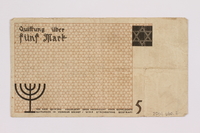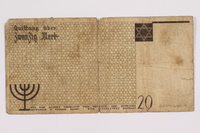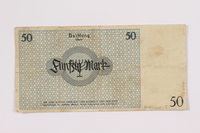Overview
- Brief Narrative
- 1 mark note receipt from the Łódź ghetto, one of 5 pieces of scrip given to Igor Belousovitch, a US soldier, in early April 1945 by a refugee walking west on the same road Igor's unit was taking east across Germany near Leipzig. As Igor was looking at the line of refugees, one looked over at him and they made eye contact. The man, emaciated and dressed in rags, walked over to Igor, reached in his pocket, pulled out several bills, and gave them to Igor. They exchanged a few words and then both continued on their way. The scrip was created in the Łódź ghetto, renamed Litzmannstadt, in German occupied Poland beginning in May 1940. When the Germans incarcerated Jews in the ghetto, they confiscated all currency in exchange for Quittungen [receipts] that could be spent only inside the ghetto. The scrip, designed by the Judenrat [Jewish Council], is decorated with traditional Jewish symbols. Igor, age 21, enlisted in the US Army in 1943. He was assigned to the 273rd Regiment, 69th Infantry Division. Igor, a native Russian speaker, was the translator at the historic April 25, 1945, meeting of American and Soviet forces at the Elbe River in Germany where they celebrated their successful efforts to destroy Fascism in Europe.
- Date
-
issue:
1940 May 15
received: 1945 April
- Geography
-
issue:
Litzmannstadt-Getto (Łódź, Poland);
Łódź (Poland)
received: Leipzig (Germany)
- Credit Line
- United States Holocaust Memorial Museum Collection, Gift of Igor Belousovitch and Rhoda Honigberg
- Markings
- face, serial number, red ink : Nº 1636372
face, upper right, black ink : Quittung / über [Receipt for about]
face, center, bold font, black ink : Eine Mark [One Mark]
face, bottom, black ink : Der Aelteste der Juden / in Litzmannstadt / M. Rumkowski / Litzmannstadt , den 15 Mai 1940 [The Eldest of the Jews / M. Rumkowski / on May 15, 1940]
back, black ink : Quittung / über / Eine Mark [Receipt for about one mark]
back, bottom, black ink : WER DIESE QUITTUNG VERFÄLSCHT ODER NACH. / MACHT ODER GEFÄLSCHTE QUITTUNGEN IN / VERKEHR BRINGT WIRD STRENGSTENS BESTRAFT [ANYONE WHO FALSIFIES OR COPIES THIS RECEIPT, OR TRAFFICS IN COUNTERFEIT RECEIPTS, WILL BE STRICTLY PUNISHED] - Contributor
-
Subject:
Igor Belousovitch
- Biography
-
Igor Belousovitch was born in April 1922 in Shanghai, China, to Nadejda (Nadine) (1894-1983) and Nicholas Belousovitch (1891-1956), both born in Russia. His father was an aviator and had been a White Russian Army officer. He fled Russia to Shanghai following the Communist revolution, civil war, and the founding of the Soviet Socialist Republic. The family immigrated to the United States in July 1923 and settled in San Francisco. In 1941, Belousovitch enrolled in the University of California, Berkeley. That December, the United States entered World War ll. Belousovitch enlisted in the US Army in 1943. He was assigned to the 273rd Regiment, 69th Infantry Division. The Fighting 69th went into the front lines in Europe on February 11, 1945, and, with other American and British troops, soon smashed through the Siegfried Line defenses into Germany. Under the command of Major General Emil F. Reinhardt, the unit met the Soviet 58th Guards under General Rusakov on April 25, 1945, at the Elbe River in Germany. Belousovitch’s fluent Russian made him the official translator at the historic meeting. He was awarded a Bronze Star for his service.
After leaving the army, Belousovitch completed his education in Russian and Eastern European studies. He later studied at Georgetown University. He married Marie (1923-2002) and had a daughter. He had a distinguished career as a top Kremlinologist in the US Department of State, Office of Analysis for the Soviet Union and Eastern Europe from 1956 until his retirement in 1991. He worked on special projects with the US military and was stationed at the US embassy in Moscow for many years. Every April since 1995, Belousovitch has attended an annual ceremony at Arlington National Ceremony at the invitation of the Russian Embassy “In tribute to the partnership in the great battle against tyranny.”
Physical Details
- Language
- German
- Classification
-
Exchange Media
- Category
-
Money
- Object Type
-
Scrip (aat)
- Physical Description
- Offwhite paper scrip printed in green ink with black text. The face has a background latticework pattern. The denomination 1 is in the lower right corner in bold font. There is a 1 inch right margin, then a rectangle with a border of barbed wire interspersed with 6-pointed Stars of David. The inside has a background of interlocked 6-pointed stars with a large star in a circle in the upper left corner and a smaller one in the center of the right border. Across the center is the denomination and other German text. The serial number in red ink replaces the upper right border. The back has a blank background with the denomination 1 in bold font in the lower left corner. There is a 1 inch left margin, then a rectangle with a border of barbed wire interspersed with 6-pointed stars. The inside has 2 sets of 8 concentric rings with the denomination 1 in the center. A scroll with the textual denomination connects the rings. The scroll crosses over a 7-branched candelabrum in the center, with German text above and below. The scrip has areas of discoloration and is worn from use.
- Dimensions
- overall: Height: 2.500 inches (6.35 cm) | Width: 4.625 inches (11.747 cm)
- Materials
- overall : paper, ink
Rights & Restrictions
- Conditions on Access
- No restrictions on access
- Conditions on Use
- No restrictions on use
Keywords & Subjects
Administrative Notes
- Legal Status
- Permanent Collection
- Provenance
- The scrip was donated to the United States Holocaust Memorial Museum in 2004 by Igor Belousovitch and Rhoda Honigberg.
- Funding Note
- The cataloging of this artifact has been supported by a grant from the Conference on Jewish Material Claims Against Germany.
- Record last modified:
- 2024-10-03 13:05:17
- This page:
- https://collections.ushmm.org/search/catalog/irn522534
Download & Licensing
In-Person Research
- By Appointment
- Request 21 Days in Advance of Visit
- Plan a Research Visit
- Request to See This Object
Contact Us
Also in Igor Belousovitch collection
The collection consists of five pieces of Łódź ghetto scrip relating to the experiences of Igor Belousovitch during World War ll when he was a soldier in the 273rd Regiment, 69th Infantry Division, United States Army, near Leipzig, Germany.
Date: 1945 April

Łódź (Litzmannstadt) ghetto scrip, 5 mark note, given to a US soldier by a refugee
Object
5 mark note receipt from the Łódź ghetto, one of 5 pieces of scrip given to Igor Belousovitch, a US soldier, in early April 1945 by a refugee walking west on the same road Igor's unit was taking east across Germany near Leipzig. As Igor was looking at the line of refugees, one looked over at him and they made eye contact. The man, emaciated and dressed in rags, walked over to Igor, reached in his pocket, pulled out several bills, and gave them to Igor. They exchanged a few words and then both continued on their way. The scrip was created in the Łódź ghetto, renamed Litzmannstadt, in German occupied Poland beginning in May 1940. When the Germans incarcerated Jews in the ghetto, they confiscated all currency in exchange for Quittungen [receipts] that could be spent only inside the ghetto. The scrip, designed by the Judenrat [Jewish Council], is decorated with traditional Jewish symbols. Igor, age 21, enlisted in the US Army in 1943. He was assigned to the 273rd Regiment, 69th Infantry Division. Igor, a native Russian speaker, was the translator at the historic April 25, 1945, meeting of American and Soviet forces at the Elbe River in Germany where they celebrated their successful efforts to destroy Fascism in Europe.
![Łódź (Litzmannstadt) ghetto scrip, 10 [zehn] mark note, given to a US soldier by a refugee Łódź (Litzmannstadt) ghetto scrip, 10 [zehn] mark note, given to a US soldier by a refugee](https://www.ushmm.org/media/emu/get?irn=522536&mm_irn=24859&file=secondary)
Łódź (Litzmannstadt) ghetto scrip, 10 [zehn] mark note, given to a US soldier by a refugee
Object
10 [zehn] mark note receipt from the Łódź ghetto, one of 5 pieces of scrip given to Igor Belousovitch, a US soldier, in early April 1945 by a refugee walking west on the same road Igor's unit was taking east across Germany near Leipzig. As Igor was looking at the line of refugees, one looked over at him and they made eye contact. The man, emaciated and dressed in rags, walked over to Igor, reached in his pocket, pulled out several bills, and gave them to Igor. They exchanged a few words and then both continued on their way. The scrip was created in the Łódź ghetto, renamed Litzmannstadt, in German occupied Poland beginning in May 1940. When the Germans incarcerated Jews in the ghetto, they confiscated all currency in exchange for Quittungen [receipts] that could be spent only inside the ghetto. The scrip, designed by the Judenrat [Jewish Council], is decorated with traditional Jewish symbols. Igor, age 21, enlisted in the US Army in 1943. He was assigned to the 273rd Regiment, 69th Infantry Division. Igor, a native Russian speaker, was the translator at the historic April 25, 1945, meeting of American and Soviet forces at the Elbe River in Germany where they celebrated their successful efforts to destroy Fascism in Europe.

Łódź (Litzmannstadt) ghetto scrip, 20 mark note, given to a US soldier by a refugee
Object
20 mark note receipt from the Łódź ghetto, one of 5 pieces of scrip given to Igor Belousovitch, a US soldier, in early April 1945 by a refugee walking west on the same road Igor's unit was taking east across Germany near Leipzig. As Igor was looking at the line of refugees, one looked over at him and they made eye contact. The man, emaciated and dressed in rags, walked over to Igor, reached in his pocket, pulled out several bills, and gave them to Igor. They exchanged a few words and then both continued on their way. The scrip was created in the Łódź ghetto, renamed Litzmannstadt, in German occupied Poland beginning in May 1940. When the Germans incarcerated Jews in the ghetto, they confiscated all currency in exchange for Quittungen [receipts] that could be spent only inside the ghetto. The scrip, designed by the Judenrat [Jewish Council], is decorated with traditional Jewish symbols. Igor, age 21, enlisted in the US Army in 1943. He was assigned to the 273rd Regiment, 69th Infantry Division. Igor, a native Russian speaker, was the translator at the historic April 25, 1945, meeting of American and Soviet forces at the Elbe River in Germany where they celebrated their successful efforts to destroy Fascism in Europe.

Łódź (Litzmannstadt) ghetto scrip, 50 mark note, given to a US soldier by a refugee
Object
50 mark note receipt from the Łódź ghetto, one of 5 pieces of scrip given to Igor Belousovitch, a US soldier, in early April 1945 by a refugee walking west on the same road Igor's unit was taking east across Germany near Leipzig. As Igor was looking at the line of refugees, one looked over at him and they made eye contact. The man, emaciated and dressed in rags, walked over to Igor, reached in his pocket, pulled out several bills, and gave them to Igor. They exchanged a few words and then both continued on their way. The scrip was created in the Łódź ghetto, renamed Litzmannstadt, in German occupied Poland beginning in May 1940. When the Germans incarcerated Jews in the ghetto, they confiscated all currency in exchange for Quittungen [receipts] that could be spent only inside the ghetto. The scrip, designed by the Judenrat [Jewish Council], is decorated with traditional Jewish symbols. Igor, age 21, enlisted in the US Army in 1943. He was assigned to the 273rd Regiment, 69th Infantry Division. Igor, a native Russian speaker, was the translator at the historic April 25, 1945, meeting of American and Soviet forces at the Elbe River in Germany where they celebrated their successful efforts to destroy Fascism in Europe.



